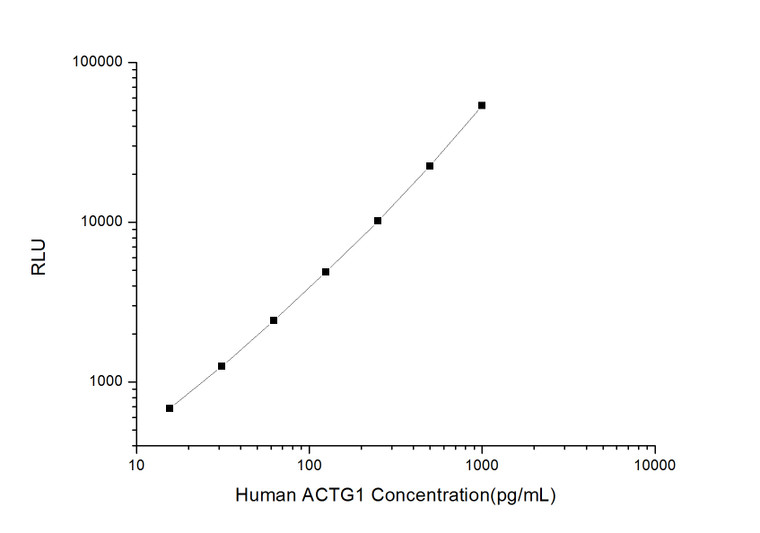| Applications: | CLIA |
| Reactivity: | Human |
| Note: | FOR SCIENTIFIC EDUCATIONAL RESEARCH USE ONLY (RUO). MUST NOT BE USED IN DIAGNOSTIC OR OTHER MEDICAL APPLICATIONS. |
| Sensitivity: | 9.38pg/mL |
| Detection Limit: | 15.63~1000pg/mL |
| Short Description: | This human ACTG1 kit is a highly sensitive in-vitro chemiluminescent immunoassay for the measurement of trace amounts of analytes. |
| Storage Instruction: | If unopened the kit may be stored at 2-8°C for up to 1 month. If the kit will not be used within 1 month, store the components separately, according to the component table in the manual. |
| Assay Time: | 3.5h |
| Detection: | Chemiluminescence |
| Gene Symbol: | ACTG1 |
| Gene ID: | 71 |
| Uniprot ID: | ACTG_HUMAN |
| Specificity: | This kit recognizes Human ACTG1 in samples. No significant cross-reactivity or interference between Human ACTG1 and analogues was observed. |
| Sample Type: | Serum, plasma and other biological fluids |
| Post Translational Modifications | Oxidation of Met-44 and Met-47 by MICALs (MICAL1, MICAL2 or MICAL3) to form methionine sulfoxide promotes actin filament depolymerization. MICAL1 and MICAL2 produce the (R)-S-oxide form. The (R)-S-oxide form is reverted by MSRB1 and MSRB2, which promote actin repolymerization. Monomethylation at Lys-84 (K84me1) regulates actin-myosin interaction and actomyosin-dependent processes. Demethylation by ALKBH4 is required for maintaining actomyosin dynamics supporting normal cleavage furrow ingression during cytokinesis and cell migration. Actin, cytoplasmic 2: N-terminal cleavage of acetylated methionine of immature cytoplasmic actin by ACTMAP. Actin, cytoplasmic 2, N-terminally processed: N-terminal acetylation by NAA80 affects actin filament depolymerization and elongation, including elongation driven by formins. In contrast, filament nucleation by the Arp2/3 complex is not affected. Methylated at His-73 by SETD3. (Microbial infection) Monomeric actin is cross-linked by V.cholerae toxins RtxA and VgrG1 in case of infection: bacterial toxins mediate the cross-link between Lys-50 of one monomer and Glu-270 of another actin monomer, resulting in formation of highly toxic actin oligomers that cause cell rounding. The toxin can be highly efficient at very low concentrations by acting on formin homology family proteins: toxic actin oligomers bind with high affinity to formins and adversely affect both nucleation and elongation abilities of formins, causing their potent inhibition in both profilin-dependent and independent manners. |
| Function | Actins are highly conserved proteins that are involved in various types of cell motility and are ubiquitously expressed in all eukaryotic cells. |
| Protein Name | Actin - Cytoplasmic 2Gamma-Actin Cleaved Into - Actin - Cytoplasmic 2 - N-Terminally Processed |
| Database Links | Reactome: R-HSA-1445148Reactome: R-HSA-190873Reactome: R-HSA-196025Reactome: R-HSA-2029482Reactome: R-HSA-3928662Reactome: R-HSA-3928665Reactome: R-HSA-418990Reactome: R-HSA-437239Reactome: R-HSA-4420097Reactome: R-HSA-445095Reactome: R-HSA-446353Reactome: R-HSA-5626467Reactome: R-HSA-5663213Reactome: R-HSA-5663220Reactome: R-HSA-5674135Reactome: R-HSA-6802946Reactome: R-HSA-6802948Reactome: R-HSA-6802952Reactome: R-HSA-6802955Reactome: R-HSA-8856828Reactome: R-HSA-9013418Reactome: R-HSA-9649948Reactome: R-HSA-9656223Reactome: R-HSA-9662360Reactome: R-HSA-9662361Reactome: R-HSA-9664422 |
| Cellular Localisation | CytoplasmCytoskeleton |
| Alternative CLIA Names | Actin - Cytoplasmic 2 CLIA kitGamma-Actin Cleaved Into - Actin - Cytoplasmic 2 - N-Terminally Processed CLIA kitACTG1 CLIA kitACTG CLIA kit |
| Specificity | This kit recognizes Human ACTG1 in samples. No significant cross-reactivity or interference between Human ACTG1 and analogues was observed. |
| Reproducibility | Both intra-CV and inter-CV are |
Information sourced from Uniprot.org
| Item | Specifications | Storage |
|---|---|---|
| Micro CLIA Plate (Dismountable) | 96T: 8 wells ×12 strips strips | -20℃, 6 months |
| Reference Standard | 96T: 2 vials 48T: 1 vial | -20℃, 6 months |
| Concentrated Biotinylated Detection Ab (100×) | 96T: 1 vial, 120 μL 60 μL | -20℃, 6 months |
| Concentrated HRP Conjugate (100×) | 96T: 1 vial, 120 μL 60 μL | -20℃ (Protect from light), 6 months |
| Reference Standard & Sample Diluent | 1 vial, 20 mL | 2-8°C, 6 months |
| Biotinylated Detection Ab Diluent | 1 vial, 14 mL | 2-8°C, 6 months |
| HRP Conjugate Diluent | 1 vial, 14 mL | 2-8°C, 6 months |
| Concentrated Wash Buffer (25×) | 1 vial, 30 mL | 2-8°C, 6 months |
| Substrate Reagent A | 1 vial, 5 mL | 2-8℃ (Protect from light) |
| Substrate Reagent B | 1 vial, 5 mL | 2-8℃ (Protect from light) |
| Plate Sealer | 5 pieces | |
| Manual | 1 copy | |
| Certificate of Analysis | 1 copy |
| Sample Type | Range (%) | Average Recovery (%) |
|---|---|---|
| Serum(n=8) | 89-103 | 96 |
| EDTA plasma(n=8) | 95-110 | 103 |
| Cell culture media(n=8) | 89-101 | 95 |
| Intra-assay Precision | Intra-assay Precision | Intra-assay Precision | Inter-assay Precision | Inter-assay Precision | Inter-assay Precision | |
|---|---|---|---|---|---|---|
| Sample | 1.00 | 2.00 | 3.00 | 1.00 | 2.00 | 3.00 |
| n | 20.00 | 20.00 | 20.00 | 20.00 | 20.00 | 20.00 |
| Mean (pg/mL) | 50.87 | 133.44 | 374.96 | 49.33 | 134.02 | 386.93 |
| Standard deviation | 4.94 | 15.68 | 42.03 | 5.34 | 11.24 | 31.65 |
| CV (%) | 9.71 | 11.75 | 11.21 | 10.83 | 8.39 | 8.18 |
12 months for antibodies. 6 months for ELISA Kits. Please see website T&Cs for further guidance







